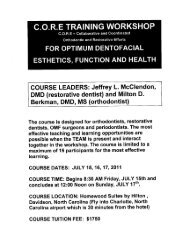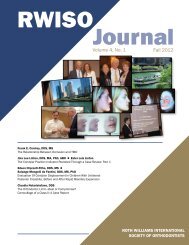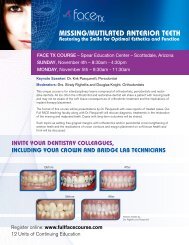2010 RWISO Journal - Roth Williams International Society of ...
2010 RWISO Journal - Roth Williams International Society of ...
2010 RWISO Journal - Roth Williams International Society of ...
Create successful ePaper yourself
Turn your PDF publications into a flip-book with our unique Google optimized e-Paper software.
Figure 10 Mandibular movements.<br />
Figure 10-a Due to wear on the canine tip, there are multiple<br />
tooth contacts on the right chewing side and harmful contacts<br />
on the left nonchewing side during the right chewing movement.<br />
Figure 10-b Incisive movement indicates<br />
multiple contacts on the posterior teeth.<br />
Figure 10-c Due to wear on the canine tip, there are multiple<br />
tooth contacts on the left chewing side and harmful contacts on<br />
the right nonchewing side during the left chewing movement.<br />
64 Linton, Jung | The Effect <strong>of</strong> Tooth Wear on Postorthodontic Pain Patients: Part 2<br />
The patient’s records were reviewed to compare the<br />
amount <strong>of</strong> tooth wear at age 15 immediately after orthodontic<br />
treatment (December 2002) with the amount <strong>of</strong> tooth<br />
wear at age 20 (Figure 11).<br />
Figure 11 Comparison <strong>of</strong> tooth wear over a 5-year period.<br />
Progression <strong>of</strong> tooth wear from 1.5 mm <strong>of</strong> vertical overbite<br />
in the upper and lower canines in December 2002 down to<br />
minimum vertical overbite in April 2008.<br />
(Red arrows indicate flattened anterior teeth.)<br />
The canine tips already showed wear at age 15. Progression<br />
<strong>of</strong> tooth wear was evident; 1.5 mm <strong>of</strong> vertical overbite in<br />
the upper and lower canines in December 2002 was reduced<br />
down to minimum vertical overbite in April 2008. The occlusal<br />
views showed the beginning <strong>of</strong> dentin exposure on the<br />
upper lateral incisors and the canines. The first molar wear<br />
caused no obvious incisal changes but the progression <strong>of</strong> the<br />
wear was definitely observable as wider wear facets and dimples<br />
on the molar cusp tips in April 2008 (Figure 12).<br />
Figure 12 Occlusal views <strong>of</strong> tooth wear. Wear on the posterior<br />
teeth is less apparent than wear on the anterior teeth. On close<br />
examination, tooth wear (red arrows) is shown as facets or<br />
dimples on the cusp tips.








